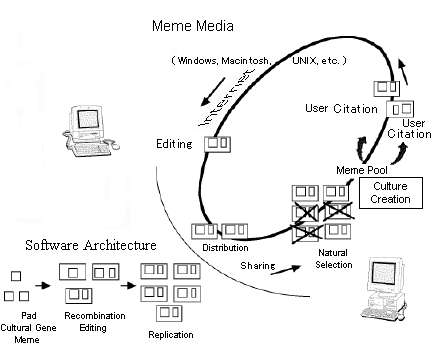 IntelligentPad System and its Practical Capability
IntelligentPad System and its Practical Capability
- The Need for IntellignetPad -
Problems with the present situation
In our highly information-oriented society, the computer and its related fields are changing at a bewildering pace. This change is certainly bringing ever greater convenience, but there are clearly aspects that need further improvement. Problems that can be seen in today's information society include the following:
- Given the rate at which the amount of information is increasing,
the structure for managing it is rather disorganized.
- Since software development still requires specialized programming
skills, productivity remains low.
- When a technology reaches a certain level, it can be expected
to become part of the culture. Computer-related technology is still having
trouble attaining this level.
To address these issues we propose the following:
- Development of media with an emphasis on convenience for the
people and communities who will use them.
- Production of the means for creating new software as compilations
of existing tools.
- Constructing new media that specifically address editing and distribution.
IntelligentPad was conceived to tackle these challenges, aiming to build a more
efficient information society.
--------------------------------------------------------
Creating a new media in which discarded Intellectual resources are effectively
used.
In this way, we can appreciate a series of acitivities of replicating,
recombining and distributing intellectual resources in various fields
--------------------------------------------------------
The IntelligentPad media architecture
Information permeates society through the following activities: (1) externalization, (2) recording and saving, (3) distribution, (4) sharing, (5) citation, and (6) editing. Unfortunately, currently one could not say that these activities are smoothly linked. Although in some places the connections are strong, weakness elsewhere often results in information ending up not being put to good use. It was felt that the key to solving this problem is to create and foster a new medium, in the computing realm, that supports all the above activities in an integrated way. That is, to create "culture" based on computers and the functions of editing and distribution.
Generally, when referring to culture what comes to mind are things such as pictures, writings, architecture and traditional arts that are valued for their historical worth. The usage of "culture" here, however, is restricted to the domain of information. In particular we are considering the accumulation of disparate pieces of knowledge and information that, by being shared, cited and edited, lead to new information and knowledge fragments that accumulate in turn.
For the computer realm to become a domain of "culture" we need a system architecture that takes into account information sharing, development and distribution. IntelligentPad has been created to act as this information-carrying medium.
--------------------------------------------------------
IntelligentPad as Meme Media
IntelligentPad, as a new media, contributes to create
more improved information-oriented society and new culture.
--------------------------------------------------------
Meme Media
Prof. Tanaka regards IntelligentPad as a "media" architecture, and in particular borrows the term "meme" (cultural gene) coined by British biologist Richard Dawkins to arrive at the concept of "meme media".
In his book "The Selfish Gene" (Oxford University Press, 1976), Dawkins proposed considering such cultural elements as fashion and music to be culture's analog of genes, participating in the same kinds of process that drive evolution in the animal world, namely genetic recombination, mutation, replication and natural selection. These processes result in the creation of new entities that imitate existing ones, sometimes with addition of new elements, and that undergo extensive dispersion and selection. In principle the theories of animal evolution can thus be applied to culture too.
"Meme media" is the result of applying Dawkins's theory to a computer-based intellectual information system. What Dawkins calls "memes" are realized as intellectual resources expressed in appropriate ways on the computer. These resources, as "pads" (either individual, or pasted together to form "composite pads"), are distributed through society by way of networks, are freely copied and disassembled, and can be combined with other pads. A composite pad, like a gene in the animal kingdom, participates in the equivalent processes of recombination and mutation, and thus evolves and develops. The idea is that if these resources become shared among many people, limitless numbers of pads will accumulate, leading to accelerated evolution of the intellectual-resource culture.
Now consider that pads acting as media containers will be produced and distributed, and will undergo replication, recombination and natural selection at the hands of their users. As media "memes" they will evolve and accumulate according to the imagination and creativity of the people who use them. By making concrete the meme concept, and providing an open infrastructure that supports it, cultural transmission can become faster and more efficient. With media memes moving freely among computers of all kinds, we will have arrived at a new form of environment for cultural and intellectual advancement.

|

